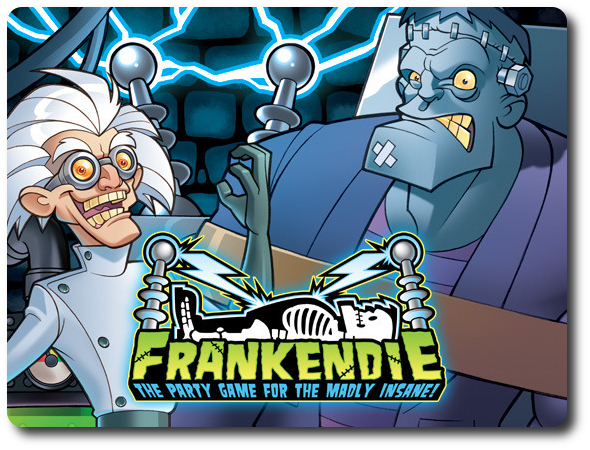
The Basics:
- For ages 4 and up (publisher suggests 6+)
- For 3 to 6 players
- Approximately 15 minutes to complete
Geek Skills:
- Active Listening & Communication
- Counting & Math
- Logical & Critical Decision Making
- Emotional Coping Skills
- Hand/Eye Coordination & Dexterity
- Memorization & Pattern/Color Matching
- Visuospatial Skills
- Reflex & Speed
Learning Curve:
- Child – Easy
- Adult – Easy
Theme & Narrative:
- What mad scientist is complete without a homemade creature to love?
Endorsements:
- Gamer Geek rejected!
- Parent Geek approved!
- Child Geek approved!
Overview
It’s tough being a Mad Scientist! Everyone fears you, the pay is lousy, and you spend most of your time either avoiding angry peasants or chasing off nosy kids. One would be wise to avoid the profession altogether if it weren’t for the fact that the benefits are awesome! Creepy castle, eccentric lab assistants, and let’s not forget your very own “build-and-control” creature! Of course, finding the bits for your creature can be a problem, especially when you have competition!
FrankenDie, designed by Al Leduc and published by UniForge Games, is comprised of 8 custom six-sided dice, 42 Body Part tiles, 6 Creature Goal cards, and 1 Graveyard tile. The images on the dice are engraved and very durable, the Body Part and Graveyard tiles are made of thick cardboard, and the Creature Goal cards are made of thick cardstock. Excellent quality throughout the entire game, from bit to box. The illustrations that depict the creatures and the Body Parts are colorful and do not show anything that I would consider inappropriate for my own children. The Body Part tiles have images where torsos are shown without any arms, legs, or head. Where the Body Parts would connect, a round crosscut that suggests bone and muscle is visible. Nothing that depicts gore, mind you, but these images might be disturbing to younger children. As always, Parent Geeks should review the game before playing it with their Child Geeks.
Lab Check
Note: The Creature Goal cards are used in a game variant. Their use is described in the “Game Variants” section below.
To set up the game, first place the Graveyard tile in the middle of the playing area.
Second, place the Body Part tiles off to one side of the playing area, but within easy reach of all the players.
That’s it for game set up. Decide who will go first and begin creating your creature!
Creature Building for Fun and Profit
FrankenDie is played in turns with no set number of turns per game. On a player’s turn, their opponents will participate in the game play, too. A typical game turn is summarized here.
Step 1: Roll Them Dice!
All the dice are collected and rolled. Dice tend to roll all over the place with younger Child Geeks throwing them. We suggest you roll the dice using the top of the game box. This keeps the dice from falling off the table and makes it easier to quickly scan the dice during step 2.
Step 2: Call Out a Set
On each of the die faces is the image of a single Body Part (head, torso, feet, arms, and brain), as well as a lighting bolt used later in the game. All players should now quickly scan the results of the dice roll and look for matching sets of Body Parts they need to complete their creature. A “set” is defined as 1 or more Body Part images. When scanning the dice, players should look for the Body Parts they need and then quickly count how many of that Body Part have been rolled. For example, “3 Legs”. When a player sees a Body Part they need and counts the total number of images shown on the dice, they then dash to the Graveyard.

Step 3: Dash to the Graveyard
Players now dash to the graveyard and attempt to smack their hand down as quickly as possible on the Graveyard tile. When doing so, they place their hand on the Graveyard tile, palm side down, and shout the name of the Body Part tile they need and the total number of images of that Body Part shown on the rolled dice. For example, “4 FEET!” If other opponents have beaten them to the Graveyard tile, the player places their hand on top of their opponents’ hands. In this way, one hand from every player will be placed on top of the Graveyard tile in a stacked formation. Obviously, don’t smack too hard or you’ll hurt the other players.
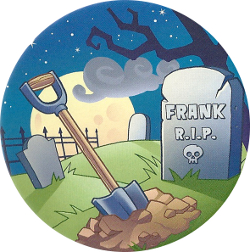
A player cannot dash to the graveyard and shout “Zero Legs!” if none are rolled, regardless of how badly they need that specific Body Part to complete their creature. At least 1 Body Part must be visible on the dice to be considered a callable set. Additionally, players cannot call a set for a Body Part they do not require to complete their creature.
Step 4: Distribute Body Parts
Once all the players have completed their dash to the graveyard, the player with their hand at the bottom of the stack removes it and checks to see if they correctly called a set. The player’s opponents SHOULD NOT remove their hands from the Graveyard tile or their position in the stack at this time. If the player correctly called the number of Body Parts (no more, no less) than what is shown on the dice, they collect 1 tile of that Body Part and add it to their creature. If the player incorrectly called a set (either by Body Part or by the number in that set), they are out of luck this turn and will not collect a Body Part tile.

The next player who has their hand at the bottom of the stack now removes their hand and checks the dice as described above. This continues until 2 correct set calls have been resolved or all the players have had a chance to review the dice to get a Body Part tile; whichever comes first.
If two correct and identical Body Part sets are called, the player who gets to resolve their call first is the only one who gets that specific Body Part tile for the turn. However, since both calls were correct, the turn is over!
This completes a game turn. The next player in turn order sequence now goes starting with step 1 noted above.
Building a Creature and Triggering the Endgame
As players collect Body Parts for their creature, they will place the tiles in front of them in a manner that would suggest the creature is being built. Although it’s not necessary to do so, it’s fun to see a project “come together”. A completed creature is comprised of 7 Body Parts.
- 1 Brain
- 1 Head
- 1 Torso
- 2 Arms
- 2 Feet
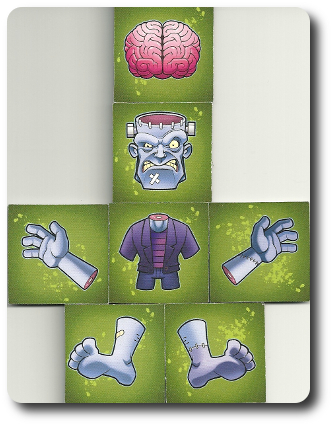
Once a player has collected the last Body Part they need to create their creature, the endgame is triggered. Note that a completed creature need only the specific number of Body Part types, but the Body Parts do not have to match. When it comes to digging in a graveyard at night for spare parts, beggars cannot be choosers. For example, the creature could have two left feet or one very manly arm and one very feminine arm.
Endgame and Bringing Your Creature to Life
The game continues even after a player has successfully built their creature with all 7 necessary Body Parts. However, the creature is not yet alive. When a player completes their creature, they require lighting to ignite the spark of life. While the player’s opponents will still be calling out Body Part sets, the player who has a completed creature will be focusing on counting the total number of lighting bolts rolled on the dice. When the player sees a set and counts the total number of lighting bolts shown, they dash to the graveyard as normal.
If, during step 4, the player is able to resolve their called set, they win the game and should yell as loudly as possible, “IT’S ALIIIIIIIIIIIIVE!!!!!” Otherwise, they must continue to play and scan the dice for lightning bolts. Remember: the faster the mad scientist is, the faster their creature will be built!
Game Variants
Custom Creature Goals
Included with FrankenDie are 6 Creature Goal cards. The Creature Goal cards are dealt to each player at random during game set up and placed in front of their owning player. The player can choose which of the two creatures on the Creature Goal card they want to use. The Creature Goal cards do not change how the game is played or won, but the player must collect the head and torso Body Part tiles that matches their Creature Goal card when possible. These Body Parts are collected in the same manner as the other Body Parts. If an opponent has the head or torso that the player needs to create their creature, they must give that specific Body Part to them in exchange for the same Body Part type the player has obtained.
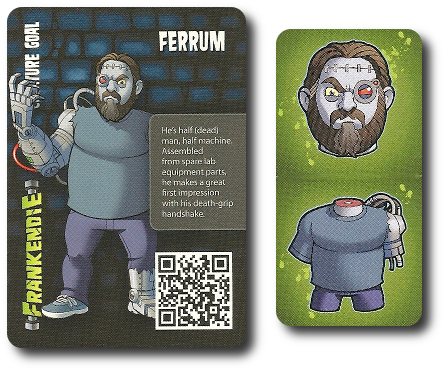
Leading (Mad) Genius
If a player has more Body Parts than their opponents, they must be the first player to correctly call a set during step 4. If they fail to do so, they do not get to collect any Body Parts for the turn. As the game continues, the leading player will change. This is a great way to help even the odds between players and introduce an additional level of difficulty to the game.
To learn more about FrankenDie, visit the game’s website.
Prediction
My little geeks and I love playing another monster dice game, Zombie Dice. However, the game lacks character interaction. A player does nothing but watch their opponents roll the dice when it’s not their turn. Sometimes a game of Zombie Dice can go on a bit too long as players continue to risk and lose, or worse yet, a player has an incredible winning streak and everyone else is helpless to stop it. There have been a number of times where my little geeks will want to stop playing out of boredom or out of growing frustration with the dice rolls. From what I know about FrankenDie, it would appear that boredom will be the last thing to be concerned about whilst playing the game! I predict that the Child Geeks will have a good time, as will the Parent Geeks. As a family game, FrankenDie is going to do well. Not too sure how well it will do if I pitch it as a Party game. For the Gamer Geeks, I don’t believe the game will be approved. FrankenDie will be perceived as nothing more than a game based on two driving principles: luck and speed. Without much depth, no real tactics to speak of, and nothing in the way of strategy, the game will be passed over.
The rules to FrankenDie are very straight forward, which makes them easy to learn and to teach. It took me only a few minutes to go over the rules and provide my three little geeks some examples before they demonstrated they understood the rules and how the game was played. I was immediately impressed that my 4-year-old was just as fast as my 6-year-old and their skill level appeared to be equally matched! This would make a game with them most interesting, to say the least! As I watched them “practice”, I began to get the impression that I was going to be the “slow player”!
THIS WOULD NOT STAND!
As I wrestled the dice away from my little geeks’ hands and got them to sit down around the table, I asked them what they thought of FrankenDie so far.
“I really, really like this! It reminds me of Zombie Dice but is much faster.” ~ Liam (age 9)
“I’m going to build a big monster and crush you, Liam!” ~ Nyhus (age 6)
“I’m going to make a zombie ninja creature, Daddy!” ~ Ronan (age 4)
Oh, I’m so excited! My little geeks are chomping at the bit to play the game and are hovering over the table, ready to pounce on the Graveyard tile ! This is going to be a fast game, but will it be fun? Let’s find out!
Final Word
My little geeks were awesome at playing FrankenDie! They were fast and cunning, often times just beating me to the Graveyard tile. They had the clear advantage as I purposely held back my slaps out of fear of hitting their hands too hard. They took full advantage of this, I am sure. I played several games with them before I sat back and just watched. Each game came down to a battle for the lightning bolts between 2 or more players. All the Child Geeks we played the game with demonstrated complete and total understanding of the rules and the game play. Not all the Child Geeks did well, however. Some of our younger players were easily distracted or simply were not as fast as their older peers. While the youngest of our Child Geek players (age 4) had no problem understanding the rules and playing the game, he never came close to winning. Introducing the Leading Genius game variant helped in almost all cases, but I observed this often times just let a player catch up versus beat a superior opponent. This, understandably, frustrated our younger and less experienced Child Geeks. They got over it. When the game was put away, all the Child Geeks voted to approve FrankenDie and were eager to build more creatures as soon as possible.
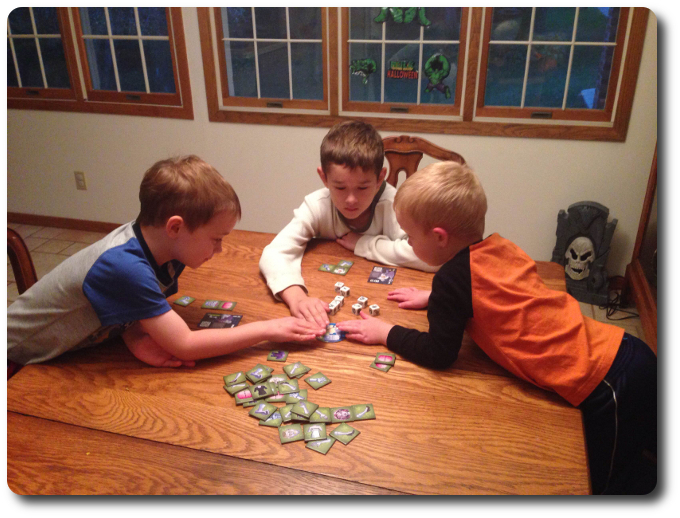
My 3 little geeks hover their hands above the Graveyard tile as they scan the dice for a needed set
The Parent Geeks found FrankenDie to be a light-hearted, fast, and fun matching game that their Child Geeks and their peers could play together. The learning curve is exceedingly easy, making the game almost immediately accessible to a wide range of ages and groups with diverse game playing experience. That would strongly suggest that FrankenDie is a party game, but none of the Parent Geeks really thought it was. Game play was quick and all the players remained involved from start to finish, leaving almost no downtime for minds to become distracted or interest to wane. According to one Parent Geek, “I really like how all the players are playing all the time. I never felt bored or left waiting. The only part I didn’t like was having my hand slapped.” Yep! As the excitement and tension builds in the game, so too does the speed and force of the hands smacking the Graveyard tile. Do expect to be smacked a bit and the table to bang. All the Parent Geeks voted to approve FrankenDie, finding it to be a monstrously good time.
The Gamer Geeks found FrankenDie to be a fast game with good rules and easy game play, but not a game that had enough depth to be given the “Gamer Geek approval” rating. FrankenDie was designed to be a light. As a result, the game’s depth is shallow and there really is nothing to suggest that strategy or tactics are present. Some of the Gamer Geeks believed FrankenDie would be a good candidate for a light filler in the same way as Zombie Dice could be, but no one thought you could make an evening out of it. According to one Gamer Geek, “The game is fun, and I’m sure I’d love playing it with my family, but I would never want to play this with Gamer Geeks.” Most of the Gamer Geeks agreed or simply were neutral towards the game. As such, FrankenDie was either rejected or simply passed over and forgotten for a game with more meat on its bones.
Perhaps the most memorable of games was my oldest little geek, Liam, versus Gamer Geek Karl. The game was fast and furious with Karl not letting up or “playing easy” against my son. Not that he had a chance to, mind you, as Liam was playing aggressively from the very beginning. Eventually, Karl got the upper hand and had a completed creature with Liam only missing one Body Part. The dice were rolled and Karl called a lightning bolt, but he hit the table too hard and some of the dice, including the one with the lightning bolt (supposedly), crashed to the floor! House Rules state that a dice off the table is a dice not counted. The roll was therefore canceled and re-rolled. Liam smashed his hand down first to claim the needed Body Part tile and there were no lighting bolts visible. Now that they both had a completed creature body, it was anyone’s game!
The tension was running high at the table as Karl rolled the dice. As fast as the lightning he was looking for, Liam called the lightning bolt set and slapped his hand down BEFORE Karl could even blurt out a sound! I checked the set called and verified it was correct. Liam had won! Karl could do nothing but hang his head down and sulk.
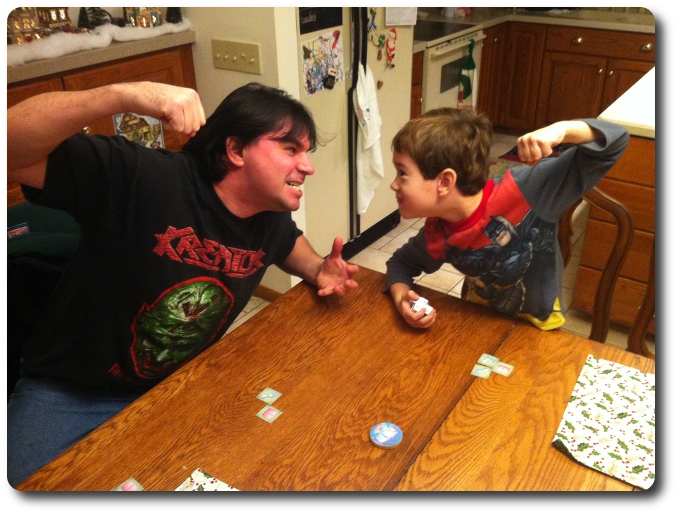
Mad Scientists, Dr. “Mad Skillz” Karl and Dr. “Awesome” Liam, battle it out for the epic win!
FrankenDie is a very entertaining Creature/Mad Scientist themed party game, although I don’t believe I’d bring it to a party. The game provides all the players a fast and furious game experience where physical reflexes are just as important as mental reflexes. Neat, but not the kind of game you’d want to play with people who you do not yet know or do not know well. Lots of hand slapping in FrankenDie and aggressive play is necessary to remain competitive. That might be a bit too much for some players at a party.
The Creature Goal cards are a nice touch, but ultimately unnecessary to the game. They were very well received by the Child Geeks, but never thought of as anything more than just more “table clutter” by the Parent and Gamer Geeks. I do suggest that you ALWAYS play with the Leading Genius game variant rule. This helps keep the game competitive and ensures that no one player leaves the others in the dust. Games will be longer, but much more entertaining.
Personally, I am very happy with FrankenDie. Zombie Dice still has a place at my gaming table, but FrankenDie has quickly become a family favorite that keeps showing up and being requested. The game was designed to be entertaining and it most certainly delivers. I’ve never left a game without a smile or a sore hand. Do check it out if you are a fan of fast games suitable for the family that provide excitement and entertainment!
This game was given to Father Geek as a review copy. Father Geek was not paid, bribed, wined, dined, or threatened in vain hopes of influencing this review. Such is the statuesque and legendary integrity of Father Geek.



